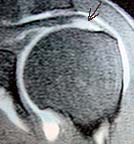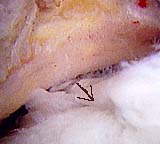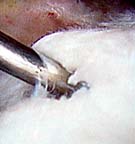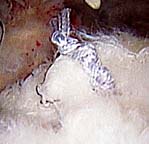

MY
ROTATOR CUFF SURGERY EXPERIENCE
A
record of the symptoms, diagnosis, surgery and healing process
(Return to the main page for more medical topics or to browse 80 other subjects: everything from kites and rocket engines to the weird world of lucid dreaming.)
Disclaimer: I am not a doctor and have had no medical training. Nothing I state should be taken as a recommendation. My experiences may have no relevance to anyone else's. I am posting this page only as an isolated example of one case so that others might get an idea of what was involved in this particular case of having an operation to correct a torn rotator cuff.
Cause and Symptoms:
For years I'd noticed a slight pulling sensation in my left shoulder while doing incline dumbbell bench presses. Two years ago, after finishing a set and proceeding to dismount, I felt and actually thought I heard something snap in that shoulder.
The pain was excruciating. After a few manly bellows of anguish the agony subsided to a mere torture level. Reason returned and I realized that I must have seriously torn a muscle. I expressed my opinion of this using several words I hadn't uttered since having to clean out latrines in the military. I make no apology for this.
After a week most of the pain was gone. I waited a full month before starting to lift again. As long as I was extra careful to move around the soreness I found I could complete the entire workout with little or no discomfort. I assumed it was just a muscle tear that had healed. I was wrong.
After 18 months I noticed that while I wasn't having any pain there was a minor, persistent ache in the shoulder that ran lengthwise down the inside front of my biceps. Although I still had complete mobility and strength in that arm, I decided, out of curiosity more than concern, to have a doctor examine it.
Diagnosis:
The doctor didn't seem to think there was anything to worry about but prescribed an MRI to take a look just to be sure. Good thing he did.
To examine the soft tissues of the shoulder with an MRI it was first necessary to have an Arthurgram done. In this procedure, a CAT scan (An X-ray where the area to be examined slowly slides through a large ring around which the X-ray emitter is rotated. The output is fed to a computer which combines all the data into a three dimensional image of the bones.) is used to pinpoint the location of the shoulder joint so that the needle of a syringe can be inserted into the gap between the bones of the joint and a dye injected. This sounds painful but I didn't feel a thing. The doctor used a topical anesthetic to dull the skin so there was no initial "prick" then injected anesthetic ahead of the needle as it was pushed in so that it was always entering dulled tissue. (This is a great technique, which I wish everyone who gives shots or takes blood samples would use.) The dye fills the layers between the soft tissues and shows up as bright areas on the MRI.
From the Cat scan room I went to the MRI room where I laid down in a long tube while the MRI made a lot of loud hammering noises as it scanned the shoulder. This took half an hour. One week later I went back to the doctor's office to get the results.
The doctor opened up the report from the MRI people and his mouth fell open. I took this as a bad sign. It was.
Heres what he saw:

The wedge shaped light area indicated by the arrow is dye that had entered an void where there should be no void.
It turns out that I had completely torn in half the middle tendon (suprasinatus) of three large tendons that make up the rotator cuff, the structure that aids in lifting the arm. The reason I was still able to use the arm was that because tendons don't have nerves there wasn't any pain and the other two tendons compensated for the loss of the middle, and most important, tendon. Left uncorrected, the condition would be degenerative and in a few years I wouldn't be able to raise the arm and the damage would be so bad that it might not be repairable. I needed surgery and I needed it soon.
Rats.
Surgery:
I went to a sports injury surgeon who confirmed the diagnosis and scheduled me for an operation five days later. He explained that the orthoscopic procedure (small holes instead of a big cut) could be accomplished with me awake by using a nerve block. The problem with this is that everything, including my head, is draped with sterile cloths and I have to lay perfectly still for an hour. He preferred to put me completely under so that the chance of my moving and messing up the operation was less. I agreed to being put completely out.
On the day of the surgery I showed up at the hospital two hours before the procedure, filled out a ton of forms, donned the required hospital gown (Why can't something better be designed?), got an IV started and after waiting an hour got rolled into the surgical room. The anesthesiologist said he was starting to inject the anesthesia and the next thing I knew I was waking up with my arm in a sling with a thousand straps to make sure the arm didn't move. I felt no pain. I was told to keep the sling on for one week at which time I'd have an appointment with the surgeon during which he would take it off and remove the stitches.
The week went by slowly with having to endure giving myself one-armed sponge baths. I found it more comfortable to sleep sitting up in a slightly reclined rocking chair. Although I was given a prescription of ultra-strong Tylenol, I ended up not needing it. As long as I kept the arm relaxed and immobile there was absolutely no discomfort.
The appointment finally arrived and the doctor removed the sling... then things got painful. Not from the arm being free, that felt great. What hurt was the removal of the tape used to hold the bandage in place. That stuff was at least ten times stronger than the best duct tape. Forget about the pain of hairs being pulled out, this stuff made it feel like the skin itself was being ripped loose. As bad as was it did serve one good purpose: shocking the nerves to the point of being insensate so that it didn't hurt so much when the doctor yanked a stitch out the wrong way so that the knot was pulled through my flesh. (Thanks, Doc.)
While all this was going on the doctor explained that everything went perfectly and gave me a photo of what the tendon looked like when he got inside.

The
arrow is pointing at a fissure in the tendon, which
should
be continuous from the middle right to the lower
left
corner of the picture. This fissure is the tear.
To
repair it he eased a drill through the tear and drilled a hole in
the bone,

mounted a dissolving anchor in the bottom of the hole, and stitched the end of the tendon to the anchor.

Over the next two months the tendon will reattach itself to the bone. This surprised me because my physical therapist said that it was the bone that would grow back around the tendon. Without a third source of information to break the tie, I assume the doctor's information is more correct.
Why the Tendon Tore:
The doctor explained that it's common for shoulder-use to form bone spurs which cause small flakes of bone to wear off. These flakes act like knives, slowly cutting into the tendon. Sometimes the tendon weakens slowly over many years and looses strength gradually. In my case he thought that the tendon had been weakened to the point where it snapped during the bench press.
He also stated that torn rotator cuff injures are very common in athletically active people. The problem with these injuries is that because of the gradual nature of the problem and, in many cases, the complete lack of pain it can go undiagnosed until the damage is so severe that repairs are difficult.
Healing:
I was told to keep the elbow down near the hip and keep the arm relaxed. I could use the arm as long as I kept it low and didn't place any strain on it. It should take two to three months for the arm to heal to the point where it is safe to begin light weight lifting.
Three weeks after the surgery I began physical therapy. The first week involved slowly swinging the arm back and forth, side to side and in small circles as it hung like a pendulum. I bent over at the waist to do these movements. During the second week these motions were augmented by lifting the arm forward, out to the side, and bending it up back behind my back using a jump rope fed through a pulley. My good arm did the pulling while the injured arm relaxed and let itself be moved. This was followed by shoulder raises and a movement where I pushed my shoulders back as if I was trying to make my shoulder blades touch. None of these movement hurt. They were proceeded by a hot compress. After the exercises I was given a cold compress while four sticky electrode pads where stuck on my shoulder and a current sent through them, which creating a tingling sensation.
The initial warmth was to loosen up the arm. The cold compress and electric shock therapy was supposed to reduce any inflammation caused by the exercises. I had this three times a week for two weeks and was told to repeat the exercises, without the compresses, on my own twice a day. (I wonder about the efficacy of the shock therapy and hot and cold compresses since most of the time I'd be exercising on my own without them.)
Even though I was out of the sling I still found it more comfortable to sleep in a chair than in bed.
At this time I could move my elbow forward nine inches before an uncomfortable tight pulling sensation in the shoulder made me stop. I could lift it outward to the side 45 degrees before it hurt. Motion to the rear was not effected. What hurt enough to bring tears to my eyes (manly tears of course) was bending the arm at the elbow so the forearm extends forward and turning the arm outward. That's a real killer. From time to time minor movements create a sensation like something is locking up in the shoulder, as if a tendon hit a snag or the joint froze because it got slightly out of line. This sensation passed in a few seconds.
On the start of the third week of therapy, six weeks after the operation, I began a series of exercises designed to begin building up the muscles as well as stretch out the shoulder: lifting a light bar straight forward and up as high as possible, pushing the arm up to the side, putting the bar behind my back and lifting the arms, and pulling on an elastic band forward, back and to the side.
I began noticing a slight grinding in the shoulder. The physical therapist stated that this was normal and usually caused by slight calcification of the tendons and/or scar tissue, both of which the exercises were designed to break down. He explained that minor aches and pains similar to those experienced while weight lifting were to be expected. The indication that something was wrong would be loud popping sounds accompanied by excruciating pain.
During the forth week I was given 2-pound hand weights and instructed in doing various arm lifts and extensions to start rebuilding muscle. The hard part of doing the lifts was not in raising the weights, but when I brought them down it felt like something was binding up in the shoulder and would finaly release with a slightly painful pop. I was told by both the doctor and physical therapist that this was normal and in time would go away.
At the end of the 7th week after the surgery, the doctor examined the shoulder and said that it had healed perfectly and that I could discontinue coming in for physical therapy as long as I continued doing the exercises at home. He said that my full range of motion should return within two months and that I should be able to start weight training again with very light weights and very low rep counts at the three month point after the surgery.
Three months after surgery I began my weight training. Following the doctor's instructions, I began with empty barbells, which only weigh five pounds each and only add five pounds per pair every other week. I found that I could work through my full regular workout with a full range of motion and without any pain. Two weeks later I added the permitted five pounds per arm and had no problems.
As of four months after the surgery I would say I am, for all intents and purposes, fully recovered. Although I'm still far short of my before-surgery strength, the loss is from normal muscle atrophy caused by lack of exercise and not due to the shoulder. My weight lifting capability is increasing steadily and I estimate that within three months I should be back to 100 percent. The shoulder still has minor moments of stiffness, but nothing that is painful or limiting.
The total bill for this surgery was $14,000, of which my therapist said the insurance company would convince the doctor to settle for something around $7,000. It would seem that one of the benefits of using medical insurance is that in addition to paying the costs, they are also good at getting doctors to accept considerably less payment than they charge. If I had to pay the bill out of pocket, I doubt I would have the knowledge and clout to be able to get the doctor and hospital to reduce their charges.
NEW!!!
Rotator
Cuff Surgery Version 2.0:
Seven years after posting this page I was standing up and lightly tightening a screw in a table top. I felt a "pop" in my right shoulder and instantly recognized it as a rotator cuff tendon giving way. Two doctor's appointments and an MRI later it was confirmed: I had a 100-percent separation of one of the rotator cuff tendons. I wasn't surprised because I'd been warned by the doctor when I tore the left shoulder that the right would probably go in the not too distant future. What did surprise me was how little force was needed to rip the tendon loose. He explained that bone fragments had weakened the tendon over the years so it took much less strain to break it than the left shoulder.
The surgery went as before and I was home by the afternoon. The doctor explained that the three anchors he used to reattach the tendon brought its strength back from zero to 30 percent and that it would take six months for the tendon to completely heal. The surgeon had installed a pain pump, a pressurized bladder that slowly leaks pain killers into the surgical area, so I expected much less pain that with the earlier operation. I was wrong.
In spite of the pain pump I was extremely uncomfortable during the day and it was bad enough so I couldn't sleep at night. I tried the Roxicet prescribed for pain but gave it up. It didn't really eliminate the pain as much as made me so stupid that I didn't care about it... or anything else. I tried 1200 mg of ibuprofen a day and that took the edge off the pain, but seemed to make my heart beat irregularly. I ended up having the grimace and bear it.
Three days later the pain pump was empty and as per the doctor's instructions, I pulled out the tube. The slight dragging sensation wasn't painful, but was uncomfortable. What was shocking is that I assumed the tube was only an inch or so under the skin. Actually, it entered near the shoulder and snaked its way eight inches under the skin to a nerve in my neck. It was extremely creepy to keep pulling more and more tube out of my skin.
Another source of discomfort was the sling. With the left shoulder the arm was strapped very securely to my side. This time the sling was much looser and a padded block held the arm 6 inches out from my side. It was much less comfortable, tended to catch on door frames, and was almost impossible in which to sleep. Even in a recliner I woke up every hour or so with the arm in pain. The odd thing was that the pain wasn't in the area of the operation, but further down the outside of the arm in the middle of the biceps. As time passed the pain decreased, but even after a month it still hurts enough to wake my up twice a night. I discovered that there are adhesive thermal pads that cover the shoulder. They last for eight hours and I found they helped a lot at night.
Of course the biggest problem is that I am right handed so I've lost almost all ability to do anything.
Three weeks after surgery I got to remove the sling, though for safety I still sleep with it but without the padded block. Two weeks after that I began physical therapy. There were only two differences between this time and the first: the addition of ultrasound treatment and pain. The ultrasound treatment consisted of rubbing a smooth probe with a 2-inch diameter head on it over the shoulder for 5 minutes. High frequency sound from the probe penetrated the muscles to provide deep heating. It's also supposed to break up scar tissue. I felt nothing during these sessions. The pain came later during therapy. (During physical therapy sessions with the left arm, the session had a very structured order starting with warming up, exercises and finally cooling down with stimulation and cold compresses. This time there was a warming/stimulation/massage step that sometimes came before the exercises and other times after it depending on how the therapy center was handling patients on any given day. They didn't seem to think the order or eliminating the cold compresses was important.)
I can't say if it's because I was 7 years older or because the shoulder was more seriously damaged, but this time around the physical therapy was never-ending torture. Stretching the shoulder was extremely painful and while it did increase the range of motion, half an hour after the stretching the arm stiffened back up. After completing 6 weeks of therapy I still don't have anywhere near a full range of motion, and this is after following a much more aggressive stretching program than with the left shoulder. The doctor and physical therapist keep telling me I have to push harder and more often. I'm spending up to two hours a day doing it and push myself to the point where the pain is almost nauseating. It's still not helping much. It's gotten to the point where I'm beginning to fear that the shoulder may never be 100-percent right again.
I'm just thankful that I've run out of shoulders to mess up.
UPDATE!!!
In
2016 while turning a sprinkler valve on, I felt and heard that
distinctive "pop" that signaled a retear of the right
rotator cuff. An MRI verified this as well as a tore biceps tendon.
Howeverm after the first week I had no pain, excellent strength and
no limitation of motion so the doctor decided against another
surgery. Part of this recommendation was based on my age (65) and the
fact that the previous surgery hadn't held.
Return to the main
page
for more medical topics or to browse 80 other subjects: everything
from kites and rocket engines to the weird world of lucid dreaming.